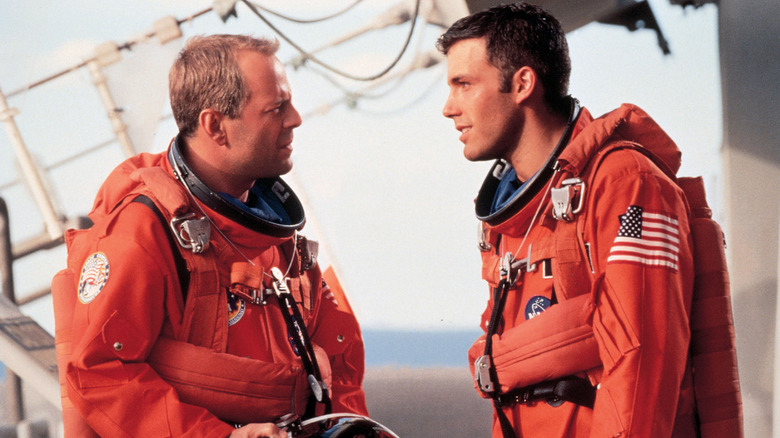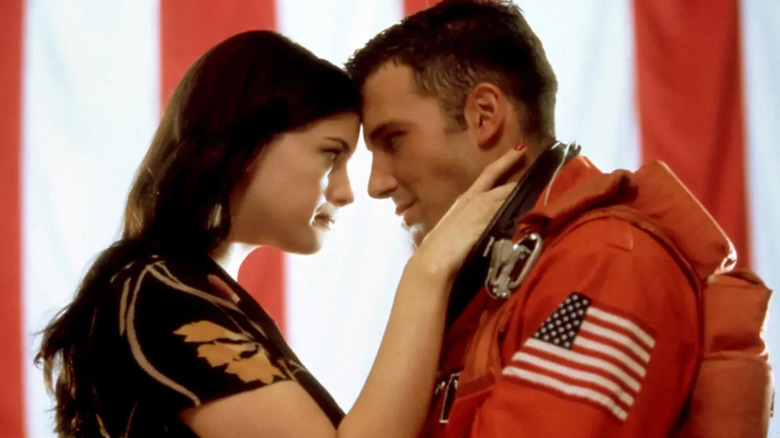How Michael Bay's Armageddon Ad Campaign Caused City-Wide Panic
1998 was the year of killer space rocks coming to annihilate Earth. "Deep Impact" was more brooding and invested in the complex human emotions and slow preparation for the inevitable. The filmmakers consulted several scientists in order to make it as scientifically accurate as possible. It was the complete opposite of the ass-kicking, American flag-waving "Armageddon" from director Michael Bay, who isn't exactly known for his subtlety.
Both movies are splats on Rotten Tomatoes and did not receive the best critical response. Even "Armageddon" star Ben Affleck himself trashed his own movie's preposterous plotline on the famously hilarious DVD commentary: "I asked Michael why it was easier to train oil drillers to become astronauts than it was to train astronauts to become oil drillers, and he told me to shut the f*** up," he said. The film centers on civilian oil drillers who embark on a convoluted mission to drill a hole and drop a bomb in an asteroid heading towards Earth. Affleck also mocked the film's obnoxious romanticizing of blue-collar conservative values:
"Bruce is going to tell the guys they did a bad job of building the drill tank. See, he's a salt of the earth guy, and the NASA nerd-onauts don't understand his salt of the Earth ways. His humble ways. Like, somehow they can build rocket ships, but they don't understand what makes a good transmission!"
Bruce Willis also had issues with "Armageddon," mainly the lack of character development and whiplash-inducing visuals. Despite these criticisms, "Armageddon" became the number one hit at the box office that summer, grossing over $500 million worldwide compared to "Deep Impact," which made just over $300 million (via Box Office Mojo). Part of that success has to do with an outstanding outdoor marketing campaign that caused a city-wide panic.
Posters put a giant asteroid-sized hole in local buildings
Leading up to the explosive summer of 1998, giant posters promoting "Armageddon" hung over the sides of buildings in Los Angeles, Chicago, and Las Vegas. The posters matched the architecture of the building itself. There was an illustration of a huge, gaping hole in the middle, as if an asteroid had just torn through it. Behind the hole was a bright blue sky, letting you "see" through the wreckage. If you were driving down the street, you would have to do a double-take because it looked so realistic.
The Hollywood Reporter points out that this giant replica of a destroyed building would never have been approved after 9/11, but before then, it was apparently "the talk of the town." It's a loud, flashy, and attention-grabbing ad — exactly like what Michael Bay's "Armageddon" turned out to be. But above all, "It was very smart and shows a great way to use outdoor campaigns," says Russell Schwartz, former New Line president of theatrical marketing. "Most outdoor [marketing] is wasted because they're basically taking the poster and just blowing it up," he continues. The "Armageddon" marketing team leaned into the spectacle of the disaster genre by making the poster as 3D and shocking as possible. It let audiences imagine what an asteroid-triggered apocalypse would really be like.
In a Facebook group dedicated to past Los Angeles architecture, fans reminisced about the advertisements, claiming that "a lot of cars careened to a stop on the road" or that it caused traffic, especially on the 405 Interstate in Los Angeles. It was a sure-fire way to make sure that future audiences wouldn't miss a thing about the upcoming summer release.

